Exploring Virtual Water Network Dynamics of China’s Electricity Trade: Insights into the Energy–Water Nexus
Abstract
:1. Introduction
2. Materials and Methods
2.1. Quantifying Virtual Water Embodied in the Electricity Trade
2.2. Portraying the Structural Characteristics of the Virtual Water Network Based on CNA
2.3. Identifying Driving Factors of Virtual Water Flow Based on the QAP
2.4. Data Sources
3. Results
3.1. Impact of Water Consumption for Electricity Production on Regional Water Stress
3.2. Hybrid Water Footprint and Virtual Water Footprint of Electricity
3.3. Evolution of Virtual Water Flow for Interprovincial Electricity Trade
3.4. Cumulative Degree Distributions of the Topological Network
3.5. Cumulative Strength Distribution of the Weighted Network
3.6. Degree Correlation of the Node Degree and Node Strength
3.7. Driving Factors of the Virtual Water Network
4. Conclusions
5. Policy Implications
Supplementary Materials
Author Contributions
Funding
Institutional Review Board Statement
Informed Consent Statement
Data Availability Statement
Conflicts of Interest
References
- Figueiredo Pereira de Faria, A.C.; Berchin, I.I.; Garcia, J.; Barbosa Back, S.N.; Andrade Guerra, J.B.S.O.d. Understanding food security and international security links in the context of climate change. Third World Q. 2016, 37, 975–997. [Google Scholar] [CrossRef]
- Benson, D.; Gain, A.K.; Rouillard, J.J. Water governance in a comparative perspective: From IWRM to a’nexus’ approach? Water Altern. 2015, 8, 756–773. [Google Scholar]
- Bleischwitz, R.; Spataru, C.; VanDeveer, S.D.; Obersteiner, M.; van der Voet, E.; Johnson, C.; Andrews-Speed, P.; Boersma, T.; Hoff, H.; Van Vuuren, D.P. Resource nexus perspectives towards the United Nations sustainable development goals. Nat. Sustain. 2018, 1, 737–743. [Google Scholar] [CrossRef]
- Williams, J.H.; DeBenedictis, A.; Ghanadan, R.; Mahone, A.; Moore, J.; Morrow III, W.R.; Price, S.; Torn, M.S. The technology path to deep greenhouse gas emissions cuts by 2050: The pivotal role of electricity. Science 2012, 335, 53–59. [Google Scholar] [CrossRef] [PubMed]
- Zhou, Y.; Li, H.; Wang, K.; Bi, J. China’s energy-water nexus: Spillover effects of energy and water policy. Glob. Environ. Chang. 2016, 40, 92–100. [Google Scholar] [CrossRef]
- Van Vliet, M.T.; Wiberg, D.; Leduc, S.; Riahi, K. Power-generation system vulnerability and adaptation to changes in climate and water resources. Nat. Clim. Chang. 2016, 6, 375–380. [Google Scholar] [CrossRef]
- Zhang, C.; Zhong, L.; Fu, X.; Wang, J.; Wu, Z. Revealing water stress by the thermal power industry in China based on a high spatial resolution water withdrawal and consumption inventory. Environ. Sci. Technol. 2016, 50, 1642–1652. [Google Scholar] [CrossRef] [PubMed]
- Zheng, X.; Wang, C.; Cai, W.; Kummu, M.; Varis, O. The vulnerability of thermoelectric power generation to water scarcity in China: Current status and future scenarios for power planning and climate change. Appl. Energy 2016, 171, 444–455. [Google Scholar] [CrossRef]
- Hoekstra, A.Y. Human appropriation of natural capital: A comparison of ecological footprint and water footprint analysis. Ecol. Econ. 2009, 68, 1963–1974. [Google Scholar] [CrossRef]
- Ali, B.; Kumar, A. Development of life cycle water-demand coefficients for coal-based power generation technologies. Energy Convers. Manag. 2015, 90, 247–260. [Google Scholar] [CrossRef]
- Liao, X.; Hall, J.W.; Eyre, N. Water use in China’s thermoelectric power sector. Glob. Environ. Change 2016, 41, 142–152. [Google Scholar] [CrossRef]
- Chai, L.; Liao, X.; Yang, L.; Yan, X. Assessing life cycle water use and pollution of coal-fired power generation in China using input-output analysis. Appl. Energy 2018, 231, 951–958. [Google Scholar] [CrossRef]
- Feng, K.; Hubacek, K.; Siu, Y.L.; Li, X. The energy and water nexus in Chinese electricity production: A hybrid life cycle analysis. Renew. Sustain. Energy Rev. 2014, 39, 342–355. [Google Scholar] [CrossRef]
- Meldrum, J.; Nettles-Anderson, S.; Heath, G.; Macknick, J. Life cycle water use for electricity generation: A review and harmonization of literature estimates. Environ. Res. Lett. 2013, 8, 015031. [Google Scholar] [CrossRef]
- Jin, Y.; Behrens, P.; Tukker, A.; Scherer, L. Water use of electricity technologies: A global meta-analysis. Renew. Sustain. Energy Rev. 2019, 115, 109391. [Google Scholar] [CrossRef]
- Allan, J.A. Fortunately there are substitutes for water otherwise our hydro-political futures would be impossible. Priorities Water Resour. Alloc. Manag. 1993, 13, 26. [Google Scholar]
- Allan, J.A. Overall perspectives on countries and regions. In Water in the Arab World: Perspectives and Prognoses; Rogers, P., Lydon, P., Eds.; Harvard University Press: Cambridge, MA, USA, 1994; pp. 65–100. [Google Scholar]
- Djehdian, L.A.; Chini, C.M.; Marston, L.; Konar, M.; Stillwell, A.S. Exposure of urban food–energy–water (FEW) systems to water scarcity. Sustain. Cities Soc. 2019, 50, 101621. [Google Scholar] [CrossRef]
- Chini, C.M.; Stillwell, A.S. The changing virtual water trade network of the European electric grid. Appl. Energy 2020, 260, 114151. [Google Scholar] [CrossRef]
- Guo, R.; Zhu, X.; Chen, B.; Yue, Y. Ecological network analysis of the virtual water network within China’s electric power system during 2007–2012. Appl. Energy 2016, 168, 110–121. [Google Scholar] [CrossRef]
- Zhang, Y.; Hou, S.; Chen, S.; Long, H.; Liu, J.; Wang, J. Tracking flows and network dynamics of virtual water in electricity transmission across China. Renew. Sustain. Energy Rev. 2021, 137, 110475. [Google Scholar] [CrossRef]
- Chini, C.M.; Djehdian, L.A.; Lubega, W.N.; Stillwell, A.S. Virtual water transfers of the US electric grid. Nat. Energy 2018, 3, 1115–1123. [Google Scholar] [CrossRef]
- Liao, X.; Zhao, X.; Hall, J.W.; Guan, D. Categorising virtual water transfers through China’s electric power sector. Appl. Energy 2018, 226, 252–260. [Google Scholar] [CrossRef]
- Zhang, C.; Zhong, L.; Liang, S.; Sanders, K.T.; Wang, J.; Xu, M. Virtual scarce water embodied in inter-provincial electricity transmission in China. Appl. Energy 2017, 187, 438–448. [Google Scholar] [CrossRef]
- Wang, R.; Zimmerman, J.B.; Wang, C.; Font Vivanco, D.; Hertwich, E.G. Freshwater vulnerability beyond local water stress: Heterogeneous effects of water-electricity nexus across the continental United States. Environ. Sci. Technol. 2017, 51, 9899–9910. [Google Scholar] [CrossRef] [PubMed]
- Chu, C.; Ritter, W.; Sun, X. Spatial variances of water-energy nexus in China and its implications for provincial resource interdependence. Energy Policy 2019, 125, 487–502. [Google Scholar] [CrossRef]
- Xi, S.; Zhang, Y.; Liu, J.; Zhang, C.; Zhang, K.; Wang, J. Evolution of interprovincial virtual water flows along with electricity transmission and its impact on water scarcity in China. J. Clean. Prod. 2021, 322, 128957. [Google Scholar] [CrossRef]
- Wang, L.; Fan, Y.V.; Varbanov, P.S.; Alwi, S.R.W.; Klemeš, J.J. Water footprints and virtual water flows embodied in the power supply chain. Water 2020, 12, 3006. [Google Scholar] [CrossRef]
- Fang, D.; Chen, B. Ecological network analysis for a virtual water network. Environ. Sci. Technol. 2015, 49, 6722–6730. [Google Scholar] [CrossRef]
- Carr, J.A.; D’Odorico, P.; Laio, F.; Ridolfi, L. On the temporal variability of the virtual water network. Geophys. Res. Lett. 2012, 39, L06404. [Google Scholar] [CrossRef]
- Dalin, C.; Suweis, S.; Konar, M.; Hanasaki, N.; Rodriguez-Iturbe, I. Modeling past and future structure of the global virtual water trade network. Geophys. Res. Lett. 2012, 39, GL053871. [Google Scholar] [CrossRef]
- Konar, M.; Dalin, C.; Hanasaki, N.; Rinaldo, A.; Rodriguez-Iturbe, I. Temporal dynamics of blue and green virtual water trade networks. Water Resour. Res. 2012, 48, 1–11. [Google Scholar] [CrossRef]
- Konar, M.; Dalin, C.; Suweis, S.; Hanasaki, N.; Rinaldo, A.; Rodriguez-Iturbe, I. Water for food: The global virtual water trade network. Water Resour. Res. 2011, 47, WR010307. [Google Scholar] [CrossRef]
- Liang, X.; Long, A.; Yu, J. The Structural Characteristics of the Virtual Water Trade Network of the China’s Major Crops. Water 2022, 14, 4083. [Google Scholar] [CrossRef]
- Sartori, M.; Schiavo, S. Connected we stand: A network perspective on trade and global food security. Food Policy 2015, 57, 114–127. [Google Scholar] [CrossRef]
- Lü, L.; Zhou, T. Link prediction in complex networks: A survey. Phys. A Stat. Mech. Its Appl. 2011, 390, 1150–1170. [Google Scholar] [CrossRef]
- Tuninetti, M.; Tamea, S.; Laio, F.; Ridolfi, L. To trade or not to trade: Link prediction in the virtual water network. Adv. Water Resour. 2017, 110, 528–537. [Google Scholar] [CrossRef]
- Zhang, C.; He, G.; Zhang, Q.; Liang, S.; Zipper, S.C.; Guo, R.; Zhao, X.; Zhong, L.; Wang, J. The evolution of virtual water flows in China’s electricity transmission network and its driving forces. J. Clean. Prod. 2020, 242, 118336. [Google Scholar] [CrossRef]
- Zhang, Y.; Hou, S.; Liu, J.; Zheng, H.; Wang, J.; Zhang, C. Evolution of virtual water transfers in China’s provincial grids and its driving analysis. Energies 2020, 13, 328. [Google Scholar] [CrossRef]
- Zhang, C.; Fu, J.; Pu, Z. A study of the petroleum trade network of countries along “The Belt and Road Initiative”. J. Clean. Prod. 2019, 222, 593–605. [Google Scholar] [CrossRef]
- Zhu, X.; Guo, R.; Chen, B.; Zhang, J.; Hayat, T.; Alsaedi, A. Embodiment of virtual water of power generation in the electric power system in China. Appl. Energy 2015, 151, 345–354. [Google Scholar] [CrossRef]
- Zhang, Y.; Hou, S.; Liu, J.; Zheng, H.; Fang, J.; Wang, J. The impacts of interprovincial electricity transmission on China’s water crisis: Mitigate or aggravate. J. Clean. Prod. 2020, 266, 121696. [Google Scholar] [CrossRef]
- Barrat, A.; Barthelemy, M.; Pastor-Satorras, R.; Vespignani, A. The architecture of complex weighted networks. Proc. Natl. Acad. Sci. USA 2004, 101, 3747–3752. [Google Scholar] [CrossRef]
- Schultz, J.V.; Hubert, L. A nonparametric test for the correspondence between two proximity matrices. J. Educ. Stat. 1976, 1, 59–67. [Google Scholar] [CrossRef]
- Tamea, S.; Carr, J.; Laio, F.; Ridolfi, L. Drivers of the virtual water trade. Water Resour. Res. 2014, 50, 17–28. [Google Scholar] [CrossRef]
- Fracasso, A. A gravity model of virtual water trade. Ecol. Econ. 2014, 108, 215–228. [Google Scholar] [CrossRef]
- Han, Y.; Xing, W.; Hao, H.; Du, X.; Liu, C. Interprovincial Metal and GHG Transfers Embodied in Electricity Transmission across China: Trends and Driving Factors. Sustainability 2022, 14, 8898. [Google Scholar] [CrossRef]
- Zhao, X.; Li, Y.; Yang, H.; Liu, W.; Tillotson, M.; Guan, D.; Yi, Y.; Wang, H. Measuring scarce water saving from interregional virtual water flows in China. Environ. Res. Lett. 2018, 13, 054012. [Google Scholar] [CrossRef]
- Zhao, D.; Hubacek, K.; Feng, K.; Sun, L.; Liu, J. Explaining virtual water trade: A spatial-temporal analysis of the comparative advantage of land, labor and water in China. Water Res. 2019, 153, 304–314. [Google Scholar] [CrossRef]
- Afkhami, M.; Bassetti, T.; Ghoddusi, H.; Pavesi, F. Virtual Water Trade: The Implications of Capital Scarcity. 2020; 3166874. Available online: https://papers.ssrn.com/sol3/papers.cfm?abstract_id=3166874 (accessed on 12 November 2023).
- Pfister, S.; Koehler, A.; Hellweg, S. Assessing the environmental impacts of freshwater consumption in LCA. Environ. Sci. Technol. 2009, 43, 4098–4104. [Google Scholar] [CrossRef] [PubMed]
- Pfister, S.; Saner, D.; Koehler, A. The environmental relevance of freshwater consumption in global power production. Int. J. Life Cycle Assess. 2011, 16, 580–591. [Google Scholar] [CrossRef]
- Wang, L.; Wang, Y.; Lee, L.-C. Life cycle water consumption embodied in inter-provincial electricity transmission in China. J. Clean. Prod. 2020, 269, 122455. [Google Scholar] [CrossRef]
- Editorial Board. China Electric Power Yearbook; Electric Power Press: Beijing, China, 2006. [Google Scholar]
- Editorial Board. China Electric Power Yearbook; Electric Power Press: Beijing, China, 2007. [Google Scholar]
- Editorial Board. China Electric Power Yearbook; Electric Power Press: Beijing, China, 2008. [Google Scholar]
- Editorial Board. China Electric Power Yearbook; Electric Power Press: Beijing, China, 2009. [Google Scholar]
- Editorial Board. China Electric Power Yearbook; Electric Power Press: Beijing, China, 2010. [Google Scholar]
- Editorial Board. China Electric Power Yearbook; Electric Power Press: Beijing, China, 2011. [Google Scholar]
- Editorial Board. China Electric Power Yearbook; Electric Power Press: Beijing, China, 2012. [Google Scholar]
- Editorial Board. China Electric Power Yearbook; Electric Power Press: Beijing, China, 2013. [Google Scholar]
- Editorial Board. China Electric Power Yearbook; Electric Power Press: Beijing, China, 2014. [Google Scholar]
- Editorial Board. China Electric Power Yearbook; Electric Power Press: Beijing, China, 2015. [Google Scholar]
- Editorial Board. China Electric Power Yearbook; Electric Power Press: Beijing, China, 2016. [Google Scholar]
- Editorial Board. China Electric Power Yearbook; Electric Power Press: Beijing, China, 2017. [Google Scholar]
- Editorial Board. China Electric Power Yearbook; Electric Power Press: Beijing, China, 2018. [Google Scholar]
- Editorial Board. China Electric Power Yearbook; Electric Power Press: Beijing, China, 2019. [Google Scholar]
- Editorial Board. China Electric Power Yearbook; Electric Power Press: Beijing, China, 2020. [Google Scholar]
- China Electricity Council. Annual Compilation of Statistics of Power Industry; China Electricity Council: Beijing, China, 2006. [Google Scholar]
- China Electricity Council. Annual Compilation of Statistics of Power Industry; China Electricity Council: Beijing, China, 2007. [Google Scholar]
- China Electricity Council. Annual Compilation of Statistics of Power Industry; China Electricity Council: Beijing, China, 2008. [Google Scholar]
- China Electricity Council. Annual Compilation of Statistics of Power Industry; China Electricity Council: Beijing, China, 2009. [Google Scholar]
- China Electricity Council. Annual Compilation of Statistics of Power Industry; China Electricity Council: Beijing, China, 2010. [Google Scholar]
- China Electricity Council. Annual Compilation of Statistics of Power Industry; China Electricity Council: Beijing, China, 2011. [Google Scholar]
- China Electricity Council. Annual Compilation of Statistics of Power Industry; China Electricity Council: Beijing, China, 2012. [Google Scholar]
- China Electricity Council. Annual Compilation of Statistics of Power Industry; China Electricity Council: Beijing, China, 2013. [Google Scholar]
- China Electricity Council. Annual Compilation of Statistics of Power Industry; China Electricity Council: Beijing, China, 2014. [Google Scholar]
- China Electricity Council. Annual Compilation of Statistics of Power Industry; China Electricity Council: Beijing, China, 2015. [Google Scholar]
- China Electricity Council. Annual Compilation of Statistics of Power Industry; China Electricity Council: Beijing, China, 2016. [Google Scholar]
- China Electricity Council. Annual Compilation of Statistics of Power Industry; China Electricity Council: Beijing, China, 2017. [Google Scholar]
- China Electricity Council. Annual Compilation of Statistics of Power Industry; China Electricity Council: Beijing, China, 2018. [Google Scholar]
- China Electricity Council. Annual Compilation of Statistics of Power Industry; China Electricity Council: Beijing, China, 2019. [Google Scholar]
- China Electricity Council. Annual Compilation of Statistics of Power Industry; China Electricity Council: Beijing, China, 2020. [Google Scholar]
- National Bureau of Statistics. China Statistical Yearbook; China Statistics Press: Beijing, China, 2006.
- National Bureau of Statistics. China Statistical Yearbook; China Statistics Press: Beijing, China, 2007.
- National Bureau of Statistics. China Statistical Yearbook; China Statistics Press: Beijing, China, 2008.
- National Bureau of Statistics. China Statistical Yearbook; China Statistics Press: Beijing, China, 2009.
- National Bureau of Statistics. China Statistical Yearbook; China Statistics Press: Beijing, China, 2010.
- National Bureau of Statistics. China Statistical Yearbook; China Statistics Press: Beijing, China, 2011.
- National Bureau of Statistics. China Statistical Yearbook; China Statistics Press: Beijing, China, 2012.
- National Bureau of Statistics. China Statistical Yearbook; China Statistics Press: Beijing, China, 2013.
- National Bureau of Statistics. China Statistical Yearbook; China Statistics Press: Beijing, China, 2014.
- National Bureau of Statistics. China Statistical Yearbook; China Statistics Press: Beijing, China, 2015.
- National Bureau of Statistics. China Statistical Yearbook; China Statistics Press: Beijing, China, 2016.
- National Bureau of Statistics. China Statistical Yearbook; China Statistics Press: Beijing, China, 2017.
- National Bureau of Statistics. China Statistical Yearbook; China Statistics Press: Beijing, China, 2018.
- National Bureau of Statistics. China Statistical Yearbook; China Statistics Press: Beijing, China, 2019.
- National Bureau of Statistics. China Statistical Yearbook; China Statistics Press: Beijing, China, 2020.
- National Bureau of Statistics. China Environmental Statistical Yearbook; China Statistics Press: Beijing, China, 2006.
- National Bureau of Statistics. China Environmental Statistical Yearbook; China Statistics Press: Beijing, China, 2007.
- National Bureau of Statistics. China Environmental Statistical Yearbook; China Statistics Press: Beijing, China, 2008.
- National Bureau of Statistics. China Environmental Statistical Yearbook; China Statistics Press: Beijing, China, 2009.
- National Bureau of Statistics. China Environmental Statistical Yearbook; China Statistics Press: Beijing, China, 2010.
- National Bureau of Statistics. China Environmental Statistical Yearbook; China Statistics Press: Beijing, China, 2011.
- National Bureau of Statistics. China Environmental Statistical Yearbook; China Statistics Press: Beijing, China, 2012.
- National Bureau of Statistics. China Environmental Statistical Yearbook; China Statistics Press: Beijing, China, 2013.
- National Bureau of Statistics. China Environmental Statistical Yearbook; China Statistics Press: Beijing, China, 2014.
- National Bureau of Statistics. China Environmental Statistical Yearbook; China Statistics Press: Beijing, China, 2015.
- National Bureau of Statistics. China Environmental Statistical Yearbook; China Statistics Press: Beijing, China, 2016.
- National Bureau of Statistics. China Environmental Statistical Yearbook; China Statistics Press: Beijing, China, 2017.
- National Bureau of Statistics. China Environmental Statistical Yearbook; China Statistics Press: Beijing, China, 2018.
- National Bureau of Statistics. China Environmental Statistical Yearbook; China Statistics Press: Beijing, China, 2019.
- National Bureau of Statistics. China Environmental Statistical Yearbook; China Statistics Press: Beijing, China, 2020.
- Liu, J.; Zhao, D.; Gerbens-Leenes, P.; Guan, D. China’s rising hydropower demand challenges water sector. Sci. Rep. 2015, 5, 11446. [Google Scholar] [CrossRef] [PubMed]
- Wang, L.; Van Fan, Y.; Jiang, P.; Varbanov, P.S.; Klemes, J.J. Virtual water and CO2 emission footprints embodied in power trade: EU-27. Energy Policy 2021, 155, 112348. [Google Scholar] [CrossRef]
- Distefano, T.; Riccaboni, M.; Marin, G. Systemic risk in the global water input-output network. Water Resour. Econ. 2018, 23, 28–52. [Google Scholar] [CrossRef]
- Song, J.; Yin, Y.; Xu, H.; Wang, Y.; Wu, P.; Sun, S. Drivers of domestic grain virtual water flow: A study for China. Agric. Water Manag. 2020, 239, 106175. [Google Scholar] [CrossRef]
- Jin, Y.; Tang, X.; Feng, C.; Höök, M. Energy and water conservation synergy in China: 2007–2012. Resour. Conserv. Recycl. 2017, 127, 206–215. [Google Scholar] [CrossRef]

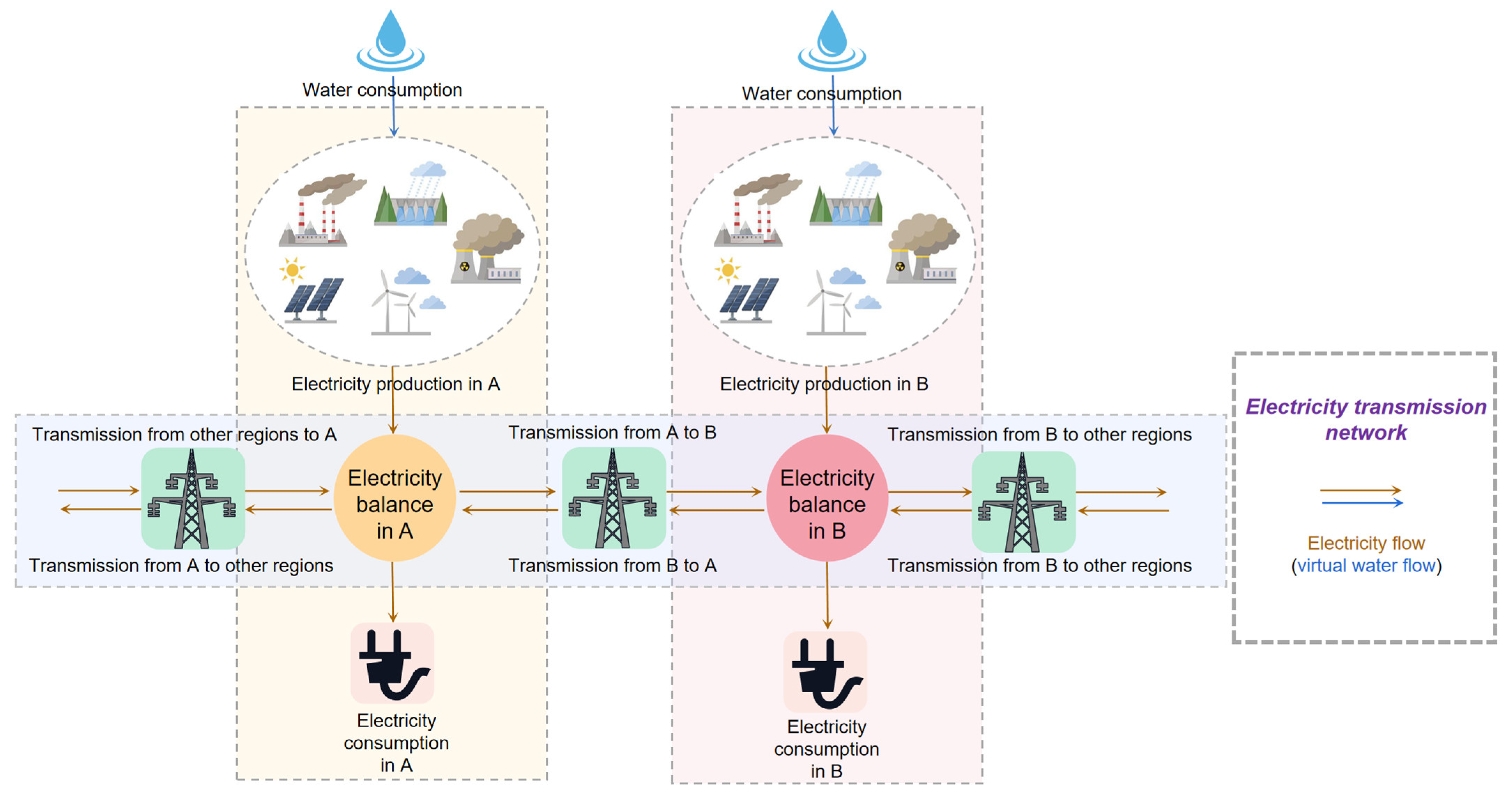


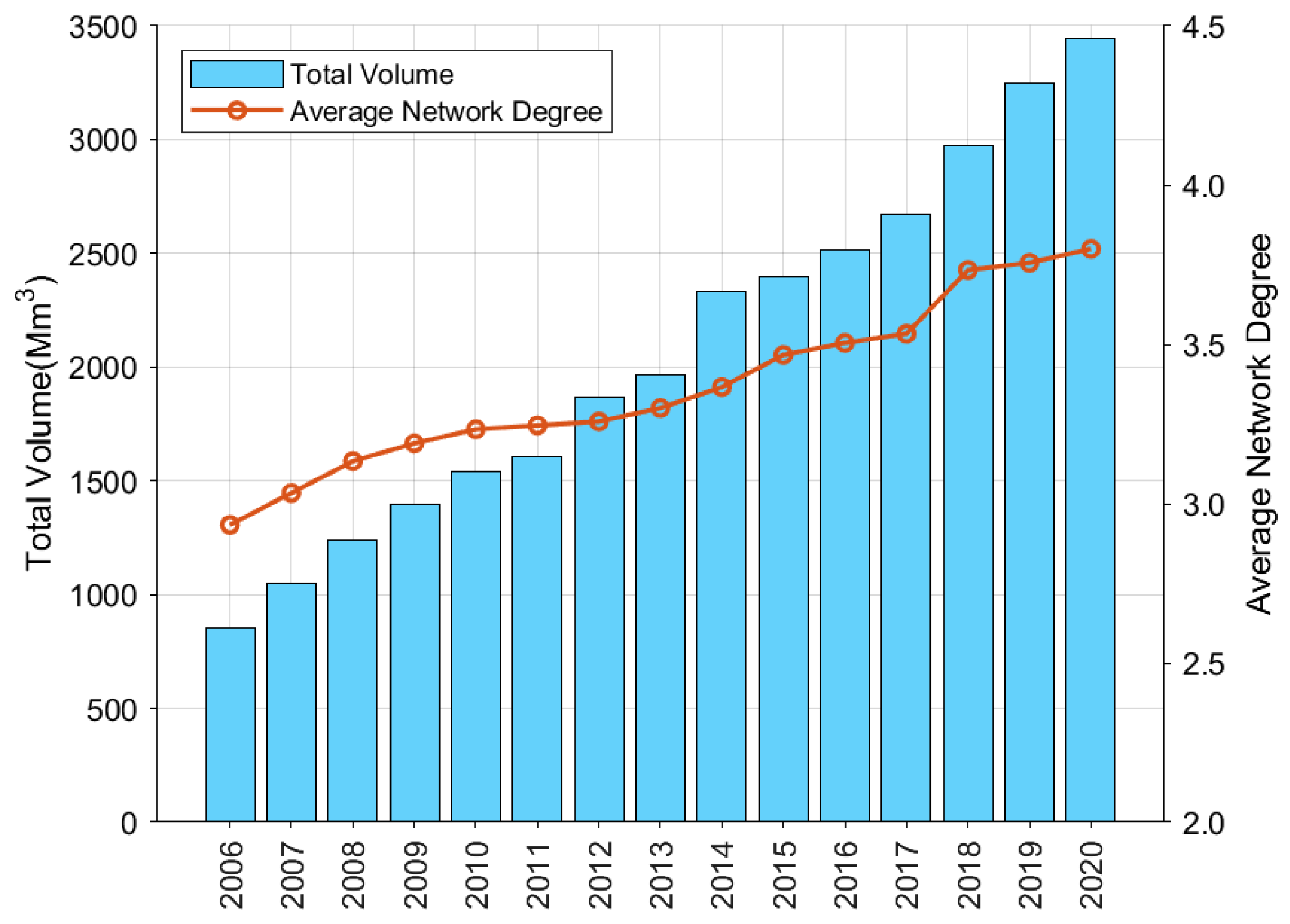
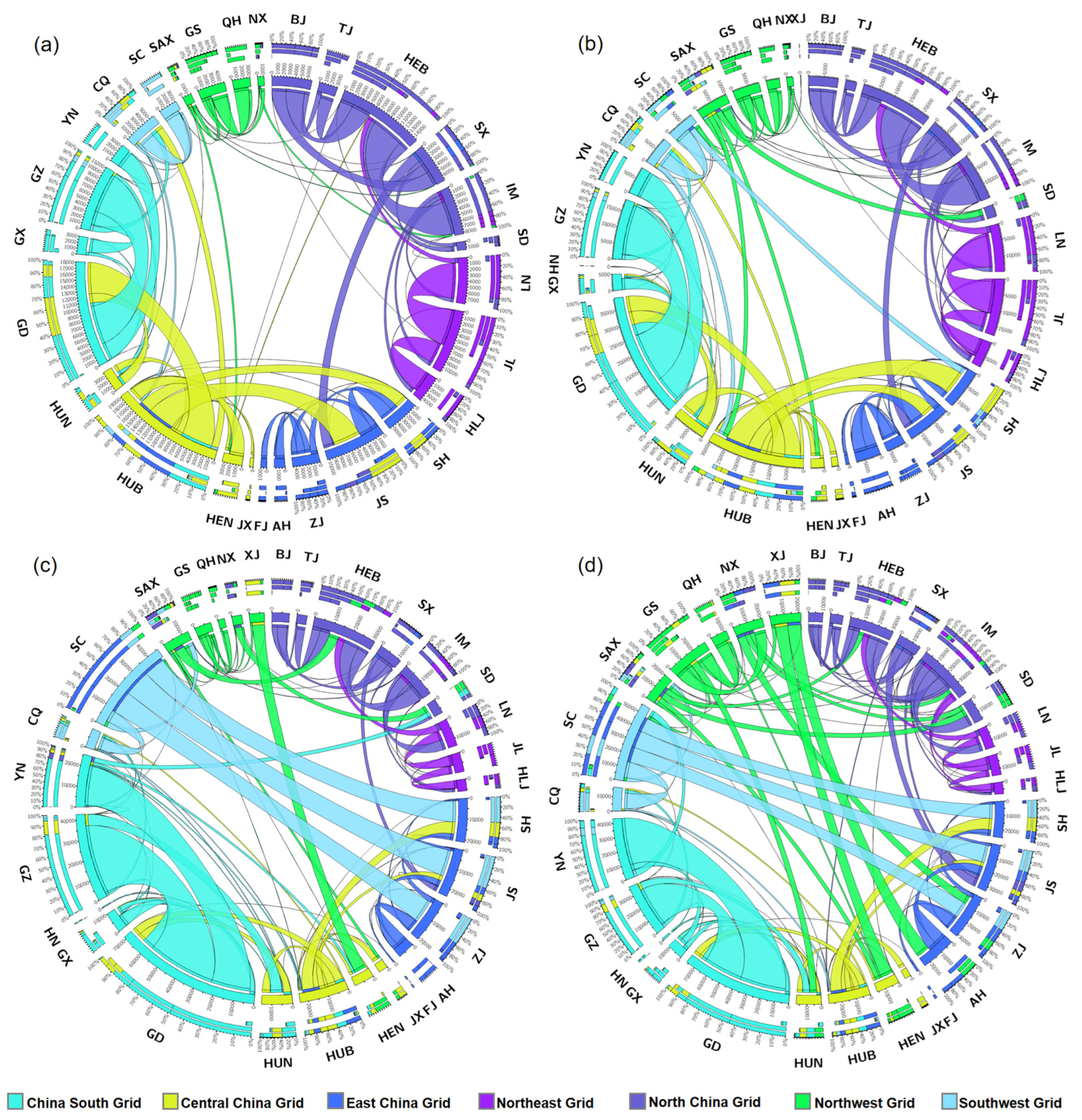

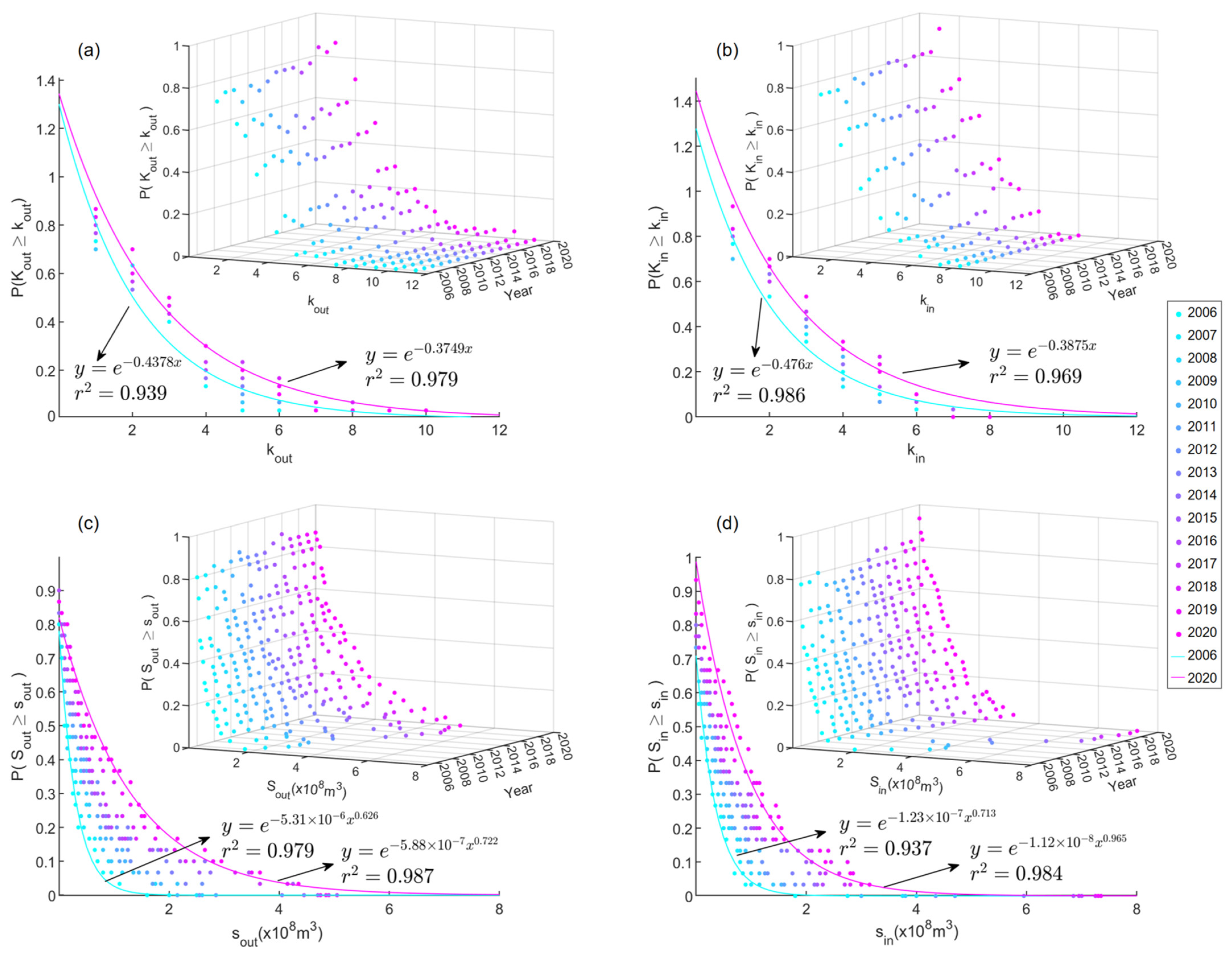

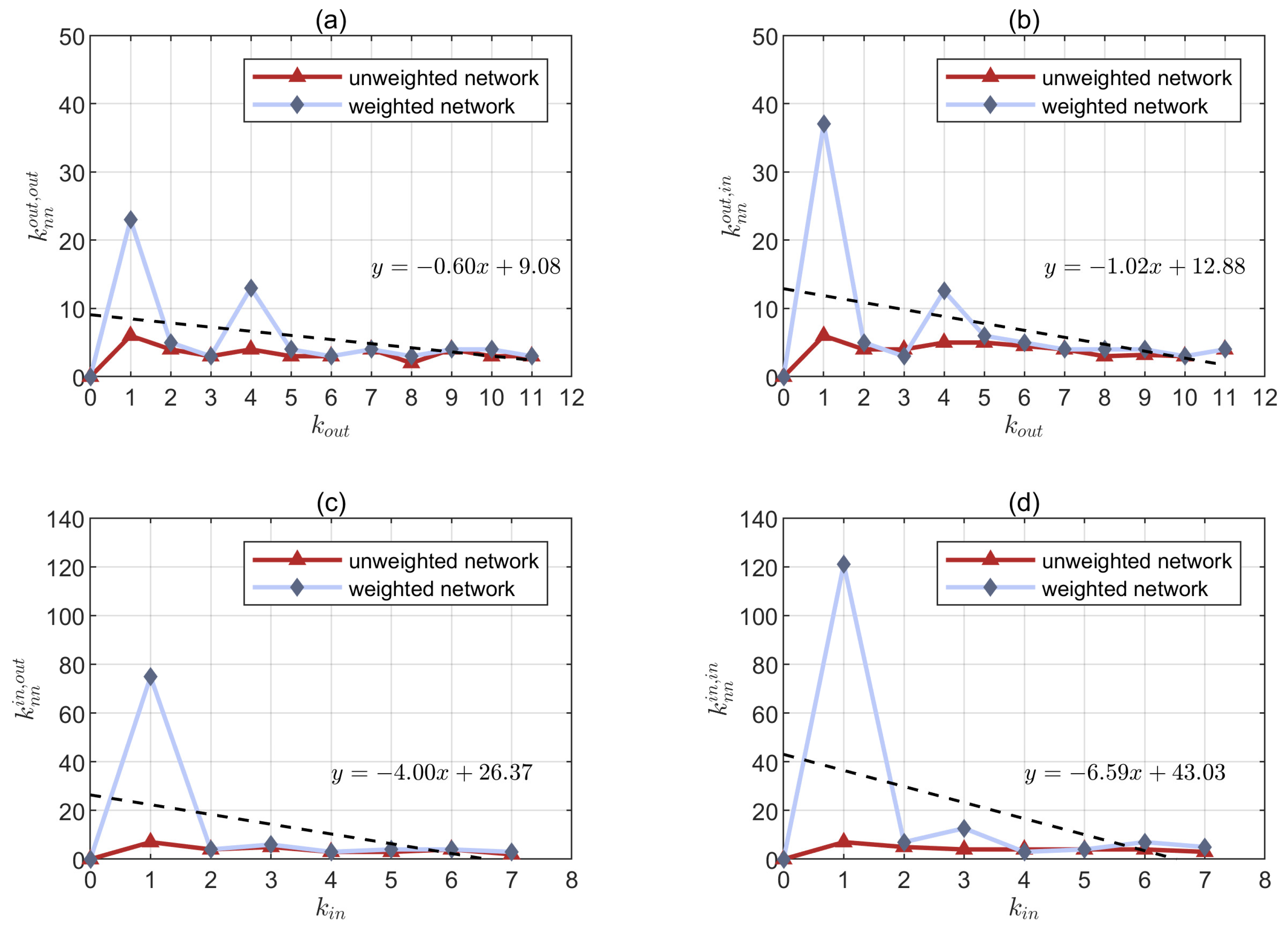
| Influencing Factor | Variable | Definition | Abbreviation |
|---|---|---|---|
| Provincial difference in power generation characteristic | Power generation level | Total power generation | PG |
| Power generation structure | Proportion of clean energy generation to total power generation | GS | |
| Feed-in tariff | Average feed-in tariff for different fuel types of power generation enterprises | FT | |
| Provincial difference in power consumption characteristic | Electricity consumption level | Total electricity consumption | EC |
| Economic level | GDP per capita | G | |
| Urbanization rate | The proportion of urban population to total population | U | |
| Grid connection | Grid connection | If there is a grid connection between provinces, the matrix element is 1, otherwise it is 0 | GC |
| Provincial difference in regional water resource characteristic | Water stress level | Water stress index | WSI |
| Water resources endowment | Available water resources per capita | WRE |
| Influencing Factors | 2006 | 2008 | 2010 | 2012 | 2014 | 2016 | 2018 | 2020 |
|---|---|---|---|---|---|---|---|---|
| GS | −0.332657 ** | −0.545052 *** | −0.436939 ** | −0.478496 *** | −0.427853 *** | −0.248762 ** | −0.211531 ** | −0.197434 ** |
| (0.030) | (0.004) | (0.012) | (0.005) | (0.003) | (0.043) | (0.048) | (0.049) | |
| FT | 0.061977 * | 0.050630 | 0.057933 | 0.067415 * | 0.070265 ** | 0.068169 ** | 0.062194 * | 0.062825 * |
| (0.058) | (0.193) | (0.112) | (0.076) | (0.046) | (0.044) | (0.056) | (0.055) | |
| EC | 0.379534 *** | 0.714432 *** | 0.499279 *** | 0.537274 *** | 0.538273 *** | 0.360563 *** | 0.312596 *** | 0.260871 *** |
| (0.003) | (0.000) | (0.001) | (0.000) | (0.000) | (0.003) | (0.003) | (0.004) | |
| G | 0.112497 * | 0.148755 * | 0.117264 * | 0.104144 * | 0.138066 * | 0.132860 * | 0.114162 * | 0.080671 * |
| (0.071) | (0.065) | (0.070) | (0.086) | (0.063) | (0.062) | (0.070) | (0.082) | |
| U | 0.071545 * | 0.121849 * | 0.104692 * | 0.112419 * | 0.138432 * | 0.139316 * | 0.132733 * | 0.107902 * |
| (0.086) | (0.077) | (0.086) | (0.071) | (0.063) | (0.064) | (0.061) | (0.083) | |
| GC | 0.645077 *** | 0.570127 *** | 0.629303 *** | 0.618124 *** | 0.589643 *** | 0.549056 *** | 0.559202 *** | 0.608854 *** |
| (0.000) | (0.000) | (0.000) | (0.000) | (0.000) | (0.000) | (0.000) | (0.000) | |
| WSI | 0.007589 | 0.007608 | 0.007607 | 0.007623 | 0.007612 | 0.007567 | 0.007546 | 0.007512 |
| (0.439) | (0.433) | (0.433) | (0.419) | (0.421) | (0.441) | (0.443) | (0.447) | |
| Observations | 870 | 870 | 870 | 870 | 870 | 870 | 870 | 870 |
| R2 | 0.436 | 0.374 | 0.418 | 0.409 | 0.400 | 0.361 | 0.356 | 0.400 |
| Adj-R2 | 0.432 | 0.369 | 0.414 | 0.405 | 0.396 | 0.357 | 0.351 | 0.396 |
Disclaimer/Publisher’s Note: The statements, opinions and data contained in all publications are solely those of the individual author(s) and contributor(s) and not of MDPI and/or the editor(s). MDPI and/or the editor(s) disclaim responsibility for any injury to people or property resulting from any ideas, methods, instructions or products referred to in the content. |
© 2023 by the authors. Licensee MDPI, Basel, Switzerland. This article is an open access article distributed under the terms and conditions of the Creative Commons Attribution (CC BY) license (https://creativecommons.org/licenses/by/4.0/).
Share and Cite
Lei, H.; Zhang, X.; Han, X. Exploring Virtual Water Network Dynamics of China’s Electricity Trade: Insights into the Energy–Water Nexus. Sustainability 2023, 15, 15977. https://doi.org/10.3390/su152215977
Lei H, Zhang X, Han X. Exploring Virtual Water Network Dynamics of China’s Electricity Trade: Insights into the Energy–Water Nexus. Sustainability. 2023; 15(22):15977. https://doi.org/10.3390/su152215977
Chicago/Turabian StyleLei, Hang, Xin Zhang, and Xinyi Han. 2023. "Exploring Virtual Water Network Dynamics of China’s Electricity Trade: Insights into the Energy–Water Nexus" Sustainability 15, no. 22: 15977. https://doi.org/10.3390/su152215977
APA StyleLei, H., Zhang, X., & Han, X. (2023). Exploring Virtual Water Network Dynamics of China’s Electricity Trade: Insights into the Energy–Water Nexus. Sustainability, 15(22), 15977. https://doi.org/10.3390/su152215977






